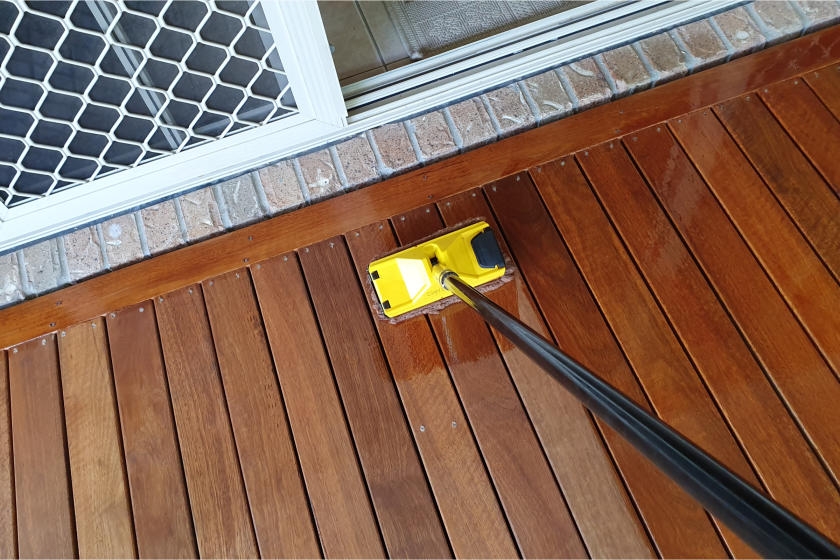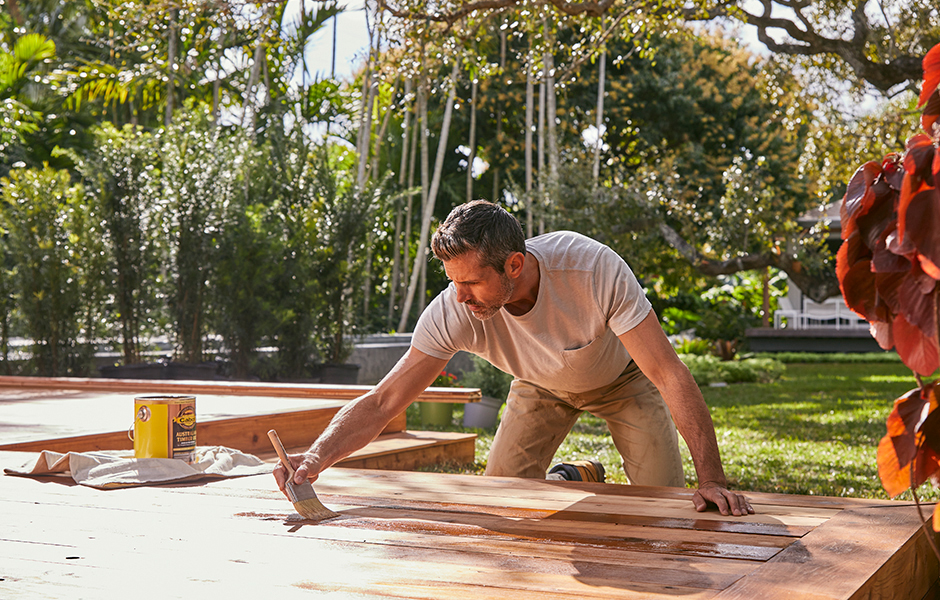Beautiful Deck Makeovers: Using the Perfect Stain
Beautiful Deck Makeovers: Using the Perfect Stain
Blog Article
A Comprehensive Overview to Various Kinds of Deck Discoloration Techniques for Ultimate Protection and Appearances
In the realm of deck upkeep, the art of tarnishing stands as a crucial step towards both preserving the integrity of your outside room and improving its aesthetic appeal. As we navigate with the complex globe of deck staining techniques, one starts to value the nuanced methods that can make all the distinction in between an average surface and a perfect one.
Comprehending Different Types of Spots
Different types of stains are commonly made use of in the process of deck discoloration to attain various aesthetic and protective impacts. On the various other hand, semi-transparent discolorations provide an equilibrium in between shade improvement and protection, enabling some timber grain to show via.
Furthermore, there are additionally specialized stains such as sealants and toners. Toners include a hint of shade to the wood while supplying minimal defense, making them suitable for newer decks with less wear. Sealers, on the other hand, deal protection versus wetness and UV rays without including color, making them a popular choice for decks that already flaunt a desirable tone. Understanding the attributes and benefits of each kind of discolor is vital for attaining the desired appearance and sturdiness for your deck.
Choosing the Right Spot Shade
When taking into consideration the aesthetics of your deck discoloration task, the choice of stain shade plays an important function in improving the safety qualities of the selected stain type (Beautiful Deck). The color you pick can substantially influence the overall appearance of your deck, as well as its capability to withstand the elements over time
When choosing a stain color, it's vital to consider the existing shade system of your home's outside. Integrating the deck stain with the general aesthetic of your residential or commercial property can create a natural and visually appealing exterior room. Additionally, the shade of your deck tarnish can affect the temperature level of the deck surface; darker shades have a tendency to soak up even more warmth, while lighter shades mirror sunshine and remain cooler.
In addition, the type of timber you are tarnishing will additionally affect just how the tarnish shade shows up. Various wood species can connect with the tarnish in different means, potentially changing the last color. It's suggested to examine the discolor on a little, inconspicuous area of the deck to ensure the shade transforms out as desired before waging the entire job.
Preparing Your Deck for Discoloration
To make sure a effective and resilient deck staining project, comprehensive preparation of the deck surface is vital. Begin by cleansing the deck extensively to eliminate dirt, crud, mold, and any old finish or discolor.
Examine the deck for any type of damaged or rotten boards that require to be changed. Hammer down any type of protruding nails and sand any kind of harsh areas to guarantee a smooth surface for staining. Examine for any type of loose barriers or browse around here actions that might need tightening up or repair service.
When the deck is clean, completely dry, and in great repair work, take into consideration using a timber brightener to bring back the deck's all-natural shade and open up the wood pores for better discolor penetration. Secure any kind of nearby plants, furnishings, or surface areas with plastic sheeting prior to proceeding with the discoloration process. Correct preparation is essential to attaining a professional-looking coating and taking full advantage of the long life of your deck discolor.
Using Stain With Numerous Methods
For a specialist and remarkable coating, the method of using tarnish plays an essential duty in boosting the appearance and longevity of your deck. There are a number of strategies you can utilize to make sure an effective application of discolor.
Brushing is a traditional method that enables accuracy and control over the quantity of discolor used. It is optimal for detailed locations and reaching between deck boards (Chicago Deck Staining). Rolling is a quicker alternative, covering larger surface successfully. However, back-brushing after rolling is recommended to level the discolor and function it right into the wood for better infiltration.
Splashing is another popular technique, offering speed and ease of application, specifically for large deck locations. It is necessary Visit Website to make use of a high-grade sprayer and bear in mind overspray. Pad applicators offer a smooth and even end up and appropriate for both upright and horizontal surfaces. Whichever method you choose, making sure appropriate preparation and following manufacturer standards will certainly aid attain a lasting and gorgeous tarnish surface on your deck.

Keeping and Re-staining Your Deck
Proper maintenance and timely re-staining are vital for protecting the beauty and long life of your deck. Regular upkeep jobs include sweeping off particles, cleaning up with a deck cleaner, and checking for any kind of signs of wear or damage. Attending to issues promptly can protect against more substantial problems in the future. When it concerns re-staining your deck, the frequency depends upon different elements such as the type of stain made use of, the climate in your area, and how much wear and tear your deck experiences. Usually, it is suggested to re-stain your deck every 2-4 years to preserve its defense and aesthetic appeals.
Before re-staining, ensure the deck is tidy, dry, and complimentary of any previous discolor deposit. Choose a high-quality tarnish that fits your deck's material and gives the preferred level of security.
Final Thought
To conclude, recognizing the different types of deck spots, official site choosing the appropriate color, correctly preparing the deck, applying tarnish with numerous methods, and re-staining the deck and preserving are important steps for best protection and aesthetics. By adhering to these steps, you can make sure that your deck continues to be in top problem for many years ahead.
Furthermore, the shade of your deck tarnish can affect the temperature of the deck surface area; darker colors have a tendency to take in even more warmth, while lighter colors reflect sunshine and stay cooler.
It's a good idea to test the stain on a tiny, low-profile area of the deck to guarantee the shade turns out as wanted before continuing with the entire project.

Report this page